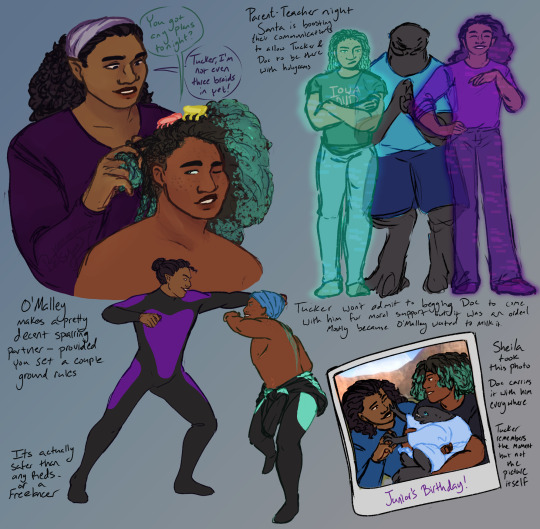#What is docker
Explore tagged Tumblr posts
Text
0 notes
Text
Decoding Kubernetes and Docker
In this evolving era, Kubernetes and Docker have come up as powerful and vital tools in the DevOps industry. In this blog, we will dive into what is Kubernetes and Docker and their components. We will also learn about the difference, benefits and challenges faced with Kubernetes and Docker. Let’s begin!
continue to reading:
1 note
·
View note
Text

sometimes u just get so filled w thoughts about a pair of characters u gotta just go bonkers ya know
#rvb#red vs blue#my art#batsy art#rvb tucker#rvb doc#rvb junior#docker#this file is called docker_and_son on my pc so ya know#tuckers hair being a mess post quest and post birth is v important to me#man got home took out his dreads and promptly fuckin immediately fell asleep face down on the floor and hasnt had a moment to retwist em#he very much meant to finish his hair first but his body had other plans#the picture has everyone in stolen clothes and that amuses me#Doc is wearing Caboose's shirt tucker is wearing one of tex's shirts and junior is wrapped up in one of church's shirts#not pictured is jr introducing doc and tucker to mason wu with 'hi mr wu this is my dad and mom-doc' 'dad doc this is mr wu :D'#and doc needs to compose himself from being called mom meanwhile junior doesnt even notice he slipped up he just auto corrected and moved o#tucker also missed it bc he was trying to figure out what mason's vibes are by force of eyebrows alone#mason wu is the only parent there who doesnt think doc and tucker are mid-messy divorce bc he looks at them and recognizes them#from pfl articles and chorus ones#so he Knows theyre soldiers and the shit they get up to and his previous frustration with juniors apparently absent family is nuked#theyre not absent theyre just keeping him Safely away from Fuckery
109 notes
·
View notes
Text
oh to have two girls stacked on top of you
51 notes
·
View notes
Text
Bull🐂Dogs 🐕

what several weeks of obsessing over rapist ex-convict dick does to a mfer @threads-strings
#if this poipiku link doesnt work youll never see me again#CONGRATS.... YOU ARE THE LOML BULLDOGS#what yapping basically nonstop for weeks does to a mfer fr#like my ass cant shut up#FUN FACT#I love them#donn the docker#sami the wolfbride#ITS FINALLY DONE#R U HAPPY#YUHHHHH#im sorry but this will not be the last time you see these bitches together im fr not letting them go#bulldogs got me like how he has her by the neck#fat dick jumpscare btw lmfao gottem
35 notes
·
View notes
Text
Donn x Innogen
“Cheer up a lil, mate. Work with a smile’n all’ at.”
- Donn while working for Bailey with Innogen LMAO

Working on a sheet with interactions :)
Innogen the lapdog belongs to @dolusectus
#I need to draw him compared to other PCs so ppl understand what a mountain this man is#Also which PC fucks up so bad Bailey sends BOTH of them STEP UP#But also I love Innogens design I think they’d have a funny dynamic with Innogen being so broody and serious LMAO#Donn the docker#Innogen the lapdog#Donn x Innogen#pc verse#goonsquad
26 notes
·
View notes
Text

Something's in the water (NOT GOOD THINGS)
forcing my own hand to the post now button
Donn belongs to @threads-strings
#NO CLUE HOW YOU FEEL ABOUT BEING TAGGED SO SORRY IN ADVANCE#big docker man and guy who steals from the docks what will they do#I DONT KNOW HOW TO DRAW HIM IM FIGURING IT OUT GUYS#firmly believe cain is insufferable to everyone. like this guy just steals everything and dips and you CANNOT seem to beat him#if you somehow tire him out he pulls out 6 canisters of pepper spray. good luck.#donn and cain will have to reach a truce somehow because if they never do one of them is ending up in a wooden box#cain the belligerent#dol pc#dol#fungus.draw#degrees of lewdity#degrees of lewdity pc#ignore the clouds and the water my ability to draw backgrounds is like dostoevskys ability to be brief and clear with his writing#ok i think thats enough tags
19 notes
·
View notes
Text
Docker Tutorial for Beginners: Learn Docker Step by Step
What is Docker?
Docker is an open-source platform that enables developers to automate the deployment of applications inside lightweight, portable containers. These containers include everything the application needs to run—code, runtime, system tools, libraries, and settings—so that it can work reliably in any environment.
Before Docker, developers faced the age-old problem: “It works on my machine!” Docker solves this by providing a consistent runtime environment across development, testing, and production.
Why Learn Docker?
Docker is used by organizations of all sizes to simplify software delivery and improve scalability. As more companies shift to microservices, cloud computing, and DevOps practices, Docker has become a must-have skill. Learning Docker helps you:
Package applications quickly and consistently
Deploy apps across different environments with confidence
Reduce system conflicts and configuration issues
Improve collaboration between development and operations teams
Work more effectively with modern cloud platforms like AWS, Azure, and GCP
Who Is This Docker Tutorial For?
This Docker tutorial is designed for absolute beginners. Whether you're a developer, system administrator, QA engineer, or DevOps enthusiast, you’ll find step-by-step instructions to help you:
Understand the basics of Docker
Install Docker on your machine
Create and manage Docker containers
Build custom Docker images
Use Docker commands and best practices
No prior knowledge of containers is required, but basic familiarity with the command line and a programming language (like Python, Java, or Node.js) will be helpful.
What You Will Learn: Step-by-Step Breakdown
1. Introduction to Docker
We start with the fundamentals. You’ll learn:
What Docker is and why it’s useful
The difference between containers and virtual machines
Key Docker components: Docker Engine, Docker Hub, Dockerfile, Docker Compose
2. Installing Docker
Next, we guide you through installing Docker on:
Windows
macOS
Linux
You’ll set up Docker Desktop or Docker CLI and run your first container using the hello-world image.
3. Working with Docker Images and Containers
You’ll explore:
How to pull images from Docker Hub
How to run containers using docker run
Inspecting containers with docker ps, docker inspect, and docker logs
Stopping and removing containers
4. Building Custom Docker Images
You’ll learn how to:
Write a Dockerfile
Use docker build to create a custom image
Add dependencies and environment variables
Optimize Docker images for performance
5. Docker Volumes and Networking
Understand how to:
Use volumes to persist data outside containers
Create custom networks for container communication
Link multiple containers (e.g., a Node.js app with a MongoDB container)
6. Docker Compose (Bonus Section)
Docker Compose lets you define multi-container applications. You’ll learn how to:
Write a docker-compose.yml file
Start multiple services with a single command
Manage application stacks easily
Real-World Examples Included
Throughout the tutorial, we use real-world examples to reinforce each concept. You’ll deploy a simple web application using Docker, connect it to a database, and scale services with Docker Compose.
Example Projects:
Dockerizing a static HTML website
Creating a REST API with Node.js and Express inside a container
Running a MySQL or MongoDB database container
Building a full-stack web app with Docker Compose
Best Practices and Tips
As you progress, you’ll also learn:
Naming conventions for containers and images
How to clean up unused images and containers
Tagging and pushing images to Docker Hub
Security basics when using Docker in production
What’s Next After This Tutorial?
After completing this Docker tutorial, you’ll be well-equipped to:
Use Docker in personal or professional projects
Learn Kubernetes and container orchestration
Apply Docker in CI/CD pipelines
Deploy containers to cloud platforms
Conclusion
Docker is an essential tool in the modern developer's toolbox. By learning Docker step by step in this beginner-friendly tutorial, you’ll gain the skills and confidence to build, deploy, and manage applications efficiently and consistently across different environments.
Whether you’re building simple web apps or complex microservices, Docker provides the flexibility, speed, and scalability needed for success. So dive in, follow along with the hands-on examples, and start your journey to mastering containerization with Docker tpoint-tech!
0 notes
Text
#Docker in DevOps#what is docker#virtual machines#docker container#what is docker in DevOpswhat is docker in DevOps#benefits of docker in DevOps#install docker
1 note
·
View note
Text
What Is the Best Way to Containerize ColdFusion Applications Using Docker?
#What Is the Best Way to Containerize ColdFusion Applications Using Docker?#Best Way to Containerize ColdFusion Applications Using Docker#Containerize ColdFusion Applications Using Docker
0 notes
Text
the only reason that Avalos mommy stays.... time to add this marc e translation affair!!!!!!!
3.4.25
3.10.25 now cut short again
Princess peony send us the right location now.












#anti feminism#amen#yolal#noway#havana jje wiz fav color#verona times square 3eeeeeeeeee#i love my family#heather madison manor was here#fuschia and magenta#what kind and sickened manner#give up your manhood#sickory hickory dockers my jeans are under my boxers#chicagoland is his spot#find his rightfully parents guide#avalo fairy girly mother#daddy's good girl#he and she quit on the spot!!!!!!!!!!#prancer#pure vanilla cookie#crazy laugh and the color turquoise
0 notes
Text
Donn x Sammy
“Y'know, yeh look a bit like a cute lass with that ponytail.”
“Huh-?”

Third part of the interaction sheet :) Almost done with it!
Sammy belongs to @jinxpantsu <3
#Donn just randomly hitting Sammy with the force fem#It’s all calculated he wants to see him try and pretend he hates getting called girl#Also he just thinks it’s funny to fuck with him ngl LMAO#donn the docker#pc verse#Samuel the transient#Donn x Sammy#What is their ship name btw cuz Sami x Donn is Bulldog
25 notes
·
View notes
Text
this just in on Things That People Say on TikTok That Make Me Mad: tools made for developers should be accessible to non developers I guess???
#some video said that the way in which the docker docs / website is written is “tech bro gatekeeping” cause its written for developers#maybe you shouldn't be messing with docker if you don't know what a command line is?#like sure theres probably some argument for improving the accessibility and quality of documentation#but as far as I can tell docker is pretty fucking good on that front
1 note
·
View note
Text
i have never learned what Terraform is but at this point I'm a bit scared to ask
#i know it's in the infra-as-code bucket.#but why do people need this whole-ass-thing to what...manage Docker deployments and K8s?#can it not be done with just a python script?
1 note
·
View note
Text
dear tumblr computer security (and birding) personality queenlua, is there any sort of chat integrator you'd trust? I have parents on WeChat, friends on SMS, other friends on WhatsApp, other friends on twitter, and one on Signal. if there could be something i run locally that takes in a jwt or whatever those apps use, i'd be so happy (to pay).
if i could force everyone in my life to use Discord it would be measurably remarkably better
#what happened to zapier#did they pivot to AI#this is super unsafe#would be really funny to have wechat on my computer as a docker image containing an old wechat binary
16 notes
·
View notes